Welfare reform - housing and social security: second follow-up paper
A report following the 2019 Annual Report on Welfare Reform focusing on the impact of UK Government Social Security policy on housing.
5. Local Housing Allowance in the private rented sector
Background
Housing costs make up a large share of household spending. Low-income households in rented accommodation are supported with their housing costs through Housing Benefit (HB) and the housing element of Universal Credit (UC). This support is available to households in both the Private and Social Rented Sectors. For the Private Rented Sector the Local Housing Allowance (LHA) rates set an upper limit on support that tenants can receive.
The proportion of households living in the private rented sector in Scotland increased substantially from just 5% in 1999 to 15% in 2016, after which it has dropped slightly to 14% in 2018.[21] From Figure 3 it is clear that average private rented sector rents for new let rental properties have largely been growing steadily across all property types in Scotland. In September 2018, around 340,000 Scottish households were renting privately, of which 60,000 were supported with their housing costs through HB and 30,000 were supported through the housing element of UC.[22] This means that of all tenants renting privately in Scotland around 27% are supported with their rents through the benefit system.
Figure 3 - Average (mean) monthly rents, by property size: Scotland, 2010 to 2018
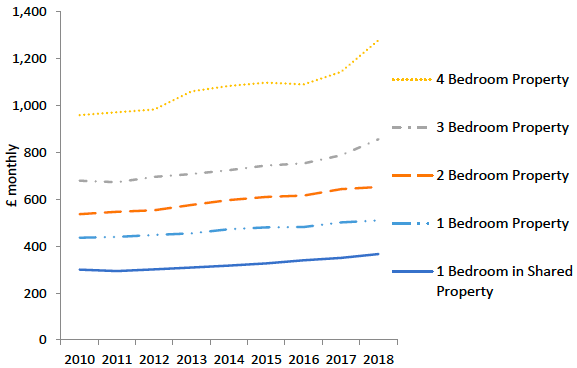
Source: Scottish Government (2018), Private sector rent statistics: 2010 - 2018 (note that this data is largely based on advertised rents, as opposed to rents for existing tenants)
Before 2012, LHA rates were set at the 50th percentile of the local market rents. In 2012, LHA rates were reduced to the 30th percentile, so that HB or UC claimants could only access the bottom 30% of properties of the relevant size in each Broad Rental Market Area (BRMA). Since 2015 LHA rates have been set at the lower of the previous year's level, or the 30th percentile of newly advertised rents. This means it is possible for LHA rates to fall, but cannot increase (other than through the provision of targeted affordability funding, small increases allocated, at the discretion of UK ministers, usually to those rates which fall furthest from the 30th percentile). Furthermore, since April 2016, LHA rates have been frozen as part of the overall welfare savings programme of the UK Government, which has further reduced the share of the private rental market that households on housing benefit can access.
Shortfall between LHA support and the 30th percentile private sector rents
Table 1 shows the weekly cash shortfall between the LHA rate and the 30th percentile rent in each BRMA. For example, a family with children entitled to a three-bedroom property in the Lothian BRMA requires an additional £89.69 per week to access renting a home at the 30th percentile of the rental market. It should be noted that the 30th percentile figure used to set the LHA rates relates to the previous year’s rents data. In Table 1 we have averaged the LHA rates over two years to estimate the shortfall with the 30th percentile. This means that the presented shortfalls are illustrative and some of the divergence between the LHA rates and the 30th percentile presented below can be attributed to the use of historical rents to set the LHA rates.
Overall, there are only a few areas where low income families are not expected to experience any shortfall. Instead, a large number of areas, particularly areas of high housing demand, continue to experience shortfalls between actual rent and available LHA support across all property types. The highest absolute shortfalls are typically experienced by large families.
Table 1: Illustrative weekly cash shortfall between the LHA rate and the actual
30th percentile by Broader Market Area
| BRMA | Shared Room | 1 Bed | 2 Bed | 3 Bed | 4 Bed |
|---|---|---|---|---|---|
| Aberdeen and Shire | £0.84 | £14.96 | £15.23 | £5.69 | £2.07 |
| Argyll and Bute | -£1.93 | -£6.67 | -£5.47 | -£6.29 | -£2.96 |
| Ayrshires | -£12.10 | £0.00 | £0.00 | £0.00 | -£13.70 |
| Dumfries and Galloway | -£2.55 | -£4.23 | -£3.45 | -£3.36 | -£7.46 |
| Dundee and Angus | -£10.20 | -£1.31 | -£7.77 | -£19.10 | -£18.05 |
| East Dunbartonshire | -£5.24 | -£11.51 | -£20.40 | -£23.73 | -£54.74 |
| Fife | -£12.79 | -£4.72 | -£3.30 | -£6.29 | -£15.05 |
| Forth Valley | -£13.57 | -£4.69 | -£11.51 | -£22.43 | -£31.08 |
| Greater Glasgow | -£6.51 | -£21.86 | -£27.31 | -£23.79 | -£92.00 |
| Highland and Islands | -£13.70 | -£6.00 | -£10.10 | -£22.67 | -£22.58 |
| Lothian | -£18.03 | -£27.63 | -£36.33 | -£89.69 | -£114.31 |
| North Lanarkshire | -£9.60 | -£5.75 | -£4.50 | -£6.76 | -£5.29 |
| Perth and Kinross | -£6.75 | -£8.50 | -£7.98 | -£12.28 | -£22.51 |
| Renfrewshire/ Inverclyde | -£5.59 | £0.00 | -£2.02 | -£1.16 | -£16.32 |
| Scottish Borders | -£5.78 | -£2.79 | -£8.06 | -£5.45 | -£45.65 |
| South Lanarkshire | -£3.88 | -£5.75 | -£5.76 | -£10.01 | -£38.63 |
| West Dunbartonshire | -£1.15 | £0.00 | £0.00 | -£6.90 | -£37.43 |
| West Lothian | -£14.76 | -£11.24 | -£14.64 | -£15.74 | -£25.52 |
Source: Scottish Government analysis based on rents data from the Rent Service Scotland (covering October 2018 and September 2018) and 2017/18 and 2018/19 LHA rates.
In the remainder of this section we discuss additional evidence that provide useful context for the interpretation of the shortfalls presented in Table 1. For example, it is important to note that not everyone will be renting a property exactly at the 30th percentile and some families may face lower or higher rental costs. Families with lower rents may face a lower gap and some families may face no shortfall at all, if the LHA rate covers their rent in full. In fact, the average weekly HB awards are consistently below the LHA rate across all BRMAs and this gap increases with property size.
Impact on Families
The average weekly award can be lower than the corresponding LHA rate for various reasons. As already stated above, families on HB or UC may rent a cheaper home and therefore would not be entitled to the maximum LHA rate. In addition, working families are entitled to lower LHA support due to tapering as a result of having income from work. This means that their average HB/UC award would be smaller and their rent shortfall would need to be covered through other household income. For example, the average two-bed LHA award in September 2018 across Scotland has been 24% lower for HB claimants who were in employment and did not receive HB as a passport from other benefits.[23] Similarly, families with rents above the maximum LHA rate would need to cover additional housing costs from other resources. It remains unclear, however, how many families face rents above the LHA rate.
For example, families in Scotland are increasingly renting privately, which can make it more difficult to find accommodation below the 30th percentile for LHA claimants. This, in turn, can in itself put upward pressure on rents as multiple tenants will be competing for the limited number of properties. This is one of the key reasons why a lot of families entitled to LHA support could be renting above the 30th percentile and would face an even higher gap than what is presented in Table 1.
In addition, there is a difference between LHA band and the actual property that a family may be living in. Where a family lives in a larger property than they are entitled to, the shortfall between actual rents and LHA support will typically be even larger. It is difficult to estimate how many families are affected by this. There may be many complex reasons behind a family’s decision to live in a property that does not match their LHA entitlement. For example, they may choose to live in a smaller property to use a higher LHA rate to access a better quality accommodation or stay in a specific location. In addition, families may choose to live in a larger property than their entitlement because of preferences or because they face barriers in moving. Barriers may be related to difficulties in finding affordable accommodation in a preferred area or fear that a new landlord may be reluctant to rent to families in receipt of benefits.[24]
What proportion of the local market can the LHA rate can access?
An alternative way of assessing the divergence between the LHA rates and the
30th percentile of the local rental market is to look at how much of the private rents in each local rental market can be covered by the LHA rate. This analysis has been previously produced by the Scottish Government in 2018 and by Crisis in 2019.[25] More recently, the National Housing Association published similar assessment for England but instead of using market rents from the Valuation Office Agency they extracted rental listings from the Zoopla website.[26] These were then compared with the LHA rate to assess the share of rental market that claimants can access across the country. The analysis concludes that only around 8% of rental properties advertised in England are accessible to LHA claimants.
Our updated analysis suggests that only 11 out of 90 LHA rates in Scotland are set at the level allowing families to rent a home in the 30 percentile of the rental market. Since the previous report whilst the situation has improved for 11 of the LHA rates, 36 of the rates have seen a reduction in the proportion of the market that is available, with 4 areas having access to less than 5% of the market. It is clear that across Scotland the underinvestment in the LHA support means it is not serving its intended purpose.
Table 2: Proportion of the private rented sector that families could access in Scotland within the LHA rates
| BRMA | Room | 1 Bed | 2 Bed | 3 Bed | 4 Bed |
|---|---|---|---|---|---|
| Aberdeen and Shire | 30% | 30% | 30% | 30% | 30% |
| Argyll and Bute | 20 to 25% | 20 to 25% | 20 to 25% | 10 to 15% | 25 to 30% |
| Ayrshires | 5 to 10% | 30% | 30% | 30% | 20 to 25% |
| Dumfries and Galloway | 15 to 20% | 20 to 25% | 25 to 30% | 15 to 20% | 25 to 30% |
| Dundee and Angus | 15 to 20% | 15 to 20% | 20 to 25% | 15 to 20% | 10 to 15% |
| East Dunbartonshire | 25 to 30% | 10 to 15% | 5 to 10% | 10 to 15% | 10 to 15% |
| Fife | 5 to 10% | 15 to 20% | 15 to 20% | 15 to 20% | 20 to 25% |
| Forth Valley | 0 to 5% | 15 to 20% | 10 to 15% | 10 to 15% | 15 to 20% |
| Greater Glasgow | 10 to 15% | 5 to 10% | 5 to 10% | 15 to 20% | 5 to 10% |
| Highland and Islands | 5 to 10% | 15 to 20% | 10 to 15% | 15 to 20% | 20 to 25% |
| Lothian | 5 to 10% | 0 to 5% | 0 to 5% | 5 to 10% | 10 to 15% |
| North Lanarkshire | 5 to 10% | 25 to 30% | 20 to 25% | 20 to 25% | 25 to 30% |
| Perth and Kinross | 10 to 15% | 10 to 15% | 10 to 15% | 15 to 20% | 10 to 15% |
| Renfrewshire/ Inverclyde | 10 to 15% | 30% | 25 to 30% | 25 to 30% | 20 to 25% |
| Scottish Borders | 15 to 20% | 15 to 20% | 20 to 25% | 20 to 25% | 5 to 10% |
| South Lanarkshire | 20 to 25% | 20 to 25% | 25 to 30% | 15 to 20% | 0 to 5% |
| West Dunbartonshire | 25 to 30% | 30% | 30% | 15 to 20% | 25 to 30% |
| West Lothian | 10 to 15% | 10 to 15% | 5 to 10% | 5 to 10% | 15 to 20% |
As private rented housing becomes increasingly less accessible to low income families, it substantially increases their risk of homelessness. Inadequate support for housing is contributing to children living in overcrowded and poor quality accommodation, as well as increasing levels of poverty and debt. While homelessness has multiple complex causes, reduced benefit income is likely to put additional pressure on the most vulnerable members of the society.
Our analysis looks at the proportion of the local rental market that different families could access within their LHA entitlement in 2017/2018 in Scotland. The family types we have looked at are:
- single people without children;
- couples without children;
- couples with children; and
- lone parents.
It is clear that the share of the rental market that families can access within the LHA rate varies substantially across different areas of Scotland. Across all LHA rates, the only area where the LHA policy is achieving the original objective of supporting private rented sector tenants in accessing the bottom 30th percentile of the local market is Aberdeen and Aberdeenshire. This is because market rents have been declining in this BRMA.
Shared Accommodation Rate
Figure 4 shows that single people aged under 35 with no child dependents who are entitled to the Shared Accommodation Room rate can face difficulties in accessing even the lower end of the private rented sector. This is particularly evident in Forth Valley, Ayrshire, Fife, the Highlands and Islands, Lothian and North Lanarkshire. Furthermore, the share of rental market that under 35s can access within the LHA rate has decreased in all areas since the first analysis has been published by the Scottish Government in 2018.
Figure 4 - The proportion of the private rented sector that single people aged under 35 with no child dependents can access in Scotland within LHA rate
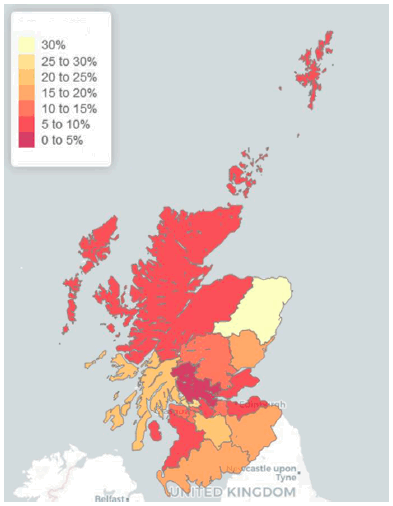
Source: Scottish Government analysis based on data from the Rent Service Scotland and 2017/18 – 2018/19 LHA rates.
As shown earlier in Table 1, the absolute estimated difference between the 30th percentile rent and the shared room rate in Forth Valley amounts to £13.57 per week. While it is a substantial shortfall, it is not the largest across all areas. Nevertheless, the shared LHA rate only enables young people to access the bottom 5% of the rental market in Forth Valley. Young people are also, on average, more likely to be single and not have child dependents which means that they are entitled to less benefit support. Inadequate LHA support could increase risk of them becoming homeless. In addition, under 35s make up only 62% of all shared rate HB claimants and remaining claimants are spread across all age groups suggesting that the adverse impacts are more wide-ranging.
Figure 5 shows the difficulties of accessing private rented sector accommodation within LHA rate for families that are entitled to one-, two- and three-bedroom properties. It is clear from the maps that the share of the rental market that is available to families in Lothian is the smallest across all BRMAs. In comparison with the shared rate, however, there are more areas where one-, two- and three-bedroom LHA rates can access a larger share of the rental market. Nevertheless, lone parents living in East Dunbartonshire, Forth Valley, Greater Glasgow and Lothian, entitled to a two- or three- bedroom LHA rate, experience significant pressure on their finances to cover rents. For example, a lone parent living in Lothian can only access the bottom 5% of the two-bed rental market and 5 to 10% of the three-bed rental market. In fact, lone parents can now access a lower share of the market than was identified in the analysis published in 2018.
Figure 5 - The proportion of the private rented sector that couples needing a one-, two- and three-bedroom property could access in Scotland within LHA rate
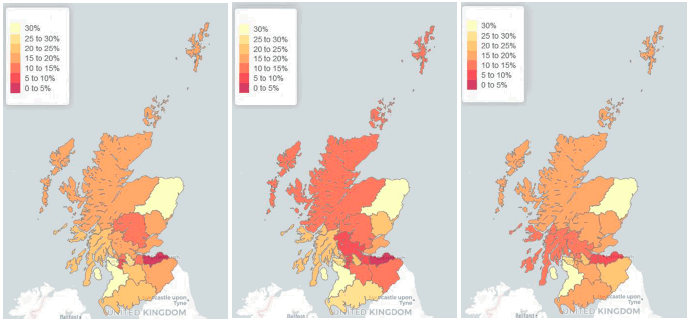 Couple without children Couple with one child Couple with two children
Couple without children Couple with one child Couple with two children
Source: Scottish Government analysis based on data from the Rent Service Scotland and 2017/18 – 2018/19 LHA rates.
Box 1: LHA rates and access to Private Rented Sector housing stock in the Lothian BRMA
Claimant numbers show that around 3,000 households were entitled to the two-bed LHA rate in the Lothian BRMA in 2018. Comparing the 3,000 figure to estimates of the size of the Private Rented Sector stock in this area suggests that approximately 7 to 10% of the total two-bedroom stock in this area in 2018 was needed for claimant households. Meanwhile, due to the LHA freezes, we estimate that only 5% of the two-bed stock in the Lothian BRMA had rents within the LHA cap, i.e. it is very likely that the number of families eligible for LHA support was greater than the amount of housing stock available within the LHA cap. Furthermore, there would have been additional demand for cheaper two-bed properties in Lothian arising from non-LHA tenants (such as other low income households or students), which would have made it even more difficult for LHA claimants to find accommodation within the LHA cap. Ultimately, this would mean that a lot of families entitled to LHA support would have had to move into properties with rents above the LHA levels unless they decided to leave the area.
Figure 6 shows the share of the local rental market that the four-bedroom LHA rate can access. Overall, this LHA rate can access a larger share of the rental market when compared with other LHA bands.
Figure 6 – Proportion of the private rented sector that a large family needing a four-bedroom property could access in Scotland within the LHA rate
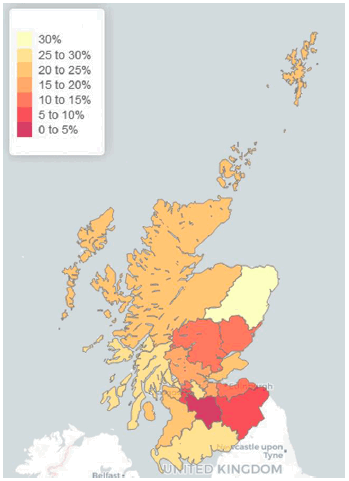
Source: Scottish Government analysis based on data from the Rent Service Scotland and 2017/18 – 2018/19 LHA rates.
From Table 1 it is clear that families living in Lothian and entitled to a four-bedroom property experience the highest weekly cash shortfall (£114.31). At the same time, however, the current Lothian LHA rate can access 10% to 15% of the rental market. In contrast, the corresponding LHA rate in South Lanarkshire can only access up to 5% of the rental market but the weekly gap between the LHA rate and 30th percentile is not the highest (£37.43). This demonstrates that the impacts of low LHA rates are complex, affect more than just areas with high housing costs and can make it difficult for families to access even the cheapest accommodation available. Furthermore, our 2018 analysis identified that families could access 15 to 20% of the local rental market in South Lanarkshire. This suggests that families are increasingly struggling to find affordable four-bed properties in this BRMA.
Figure 7 presents how caseload in each individual LHA band is split by gender and suggests that around 45% of all claimants entitled to a four-bedroom LHA rate have been couples. The remaining claims have been mostly made by single female claimants who are also likely to be lone parents.
Figure 7 – Housing Benefit PRS caseload in each LHA band by gender, Scotland (September 2018)
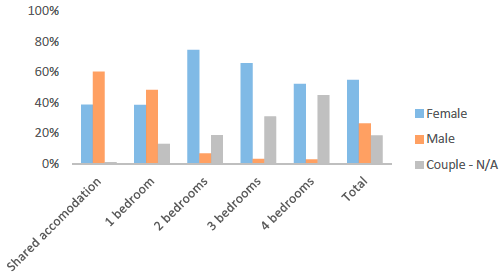
Source: Scottish Government analysis of DWP data (note that gender is only recorded for claims submitted individually).
Administrative Issues
Over and above the cuts to LHA rates, private landlords also have many issues with the administration of UC. The Scottish Association of Landlords, in their submission to the Scottish Parliament Social Security Committee’s inquiry into social security support for housing raise a number of practical issues in relation to what they describe as “the poor administration of the UC system by DWP”.
Recent research with private landlords at a UK level also suggests that UC may increase the risk of arrears. A UK-wide survey from December 2018 found that 75% of private landlords with UC tenants had experienced rent arrears in the last 12 months. Other research in England and Wales showed that 58% of 2,229 landlords had UC tenants that had fallen into rent arrears in the past 12 months - 82% of whom had entered arrears after a new claim or after migration onto UC.
The Scottish Association of Landlords has stated that “many landlords in Scotland have come to the decision that they would prefer not to take the financial risk of letting to tenants who are in receipt of Universal Credit.”
Whilst Scottish Ministers are firmly of the view that landlords should not be refusing tenancies to families on the basis of them being in receipt of benefits, it is important that the benefits system does not act to incentivise this behaviour.
Conclusion
It is clear that in many areas of Scotland the share of the rental market that is accessible to LHA claimants has become very limited. In some areas, and at some times of the year, this is likely to mean that there is not enough stock within the LHA caps for claimants. They will therefore have to rent above the LHA level and make up the shortfall. If they cannot afford to do so, they may be forced to move to another BRMA with lower rents (potentially away from their support networks and jobs), or have to apply as homeless. The UK Government has no current plans to extend the LHA Freeze after March 2020 but it is still unclear how rates will be uprated. Despite the UK Government’s Targeted Affordability Funding to increase LHA support in areas with the highest divergence and attempts by the Scottish Government to mitigate some of the adverse impacts through Discretionary Housing Payments and Scottish Welfare Fund, the impact of inadequate support on families in Scotland remains profound.
Furthermore, there is compelling evidence as to the benefits of reversing the freeze. Research by Alma Economics[27], commissioned by Crisis, shows that restoring Local Housing Allowance rates to the 30th percentile will not only have positive impact on homelessness and poverty, but would see wider economic benefits too. If the UK Government were to restore rates through a £3.3 billion investment in Local Housing Allowance rates over three years there would be wider benefits of £5.5 billion. This means there is an overall benefit of £2.1 billion to restoring Local Housing Allowance rates to cover the cheapest third of private rents to prevent and end homelessness.
Contact
Email: merlin.kemp@gov.scot
There is a problem
Thanks for your feedback